It is always interesting to explore the email spam trends across a large period of time, so this time we’ll compare spam rates within the last 12 months, from October 2011 to October 2012. Here comes the good news: the last month stats revealed an unprecedented drop in the email spam rate.
According to Symantec.Cloud data, the global spam rate dropped by more than 10%, from 75% of email traffic in September, down to 64.8% in October 2012. Please see the chart below to track the email spam trends from October 2011 to October 2012. As you can see, the last month’s spam rate is very similar to the “dead months” in 2011, March and April, when the percentage of spam messages went down to 64.52%.
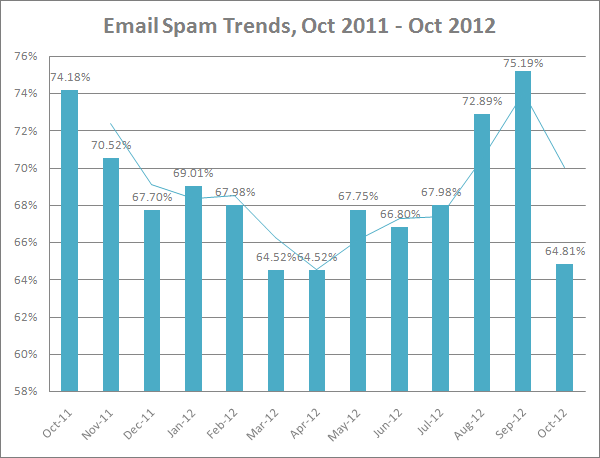
Reasons for the Sudden Drop of the Email Spam Rate in October 2012
As suggested by the editors of the latest Symantec Intelligence Report, one of the reasons for the sudden decline in email spam rates in October 2012 could be the disappearance of the Festi botnet which has apparently been hosted in Saudi Arabia in recent months.
By the way, if we take a closer look at the list of countries reported to be the sources of spam in October 2012, we are sure to notice that Saudi Arabia is no longer in the top ten list:
- India – 11.9%
- Brazil – 7.9%
- United States – 6.6%
- Canada – 5%
- Russian Federation 4.6%
- Vietnam – 4.1%
- Peru – 4%
- South Korea – 3.3%
- Romania – 3%
- Turkey – 2.9%
Unfortunately, drops like this one have been noticed before, but other botnets soon replaced the discontinued one, or a “dead” botnet was reincarnated. We’ll see how it goes within the following months,and we can truly hope that the decline will become a steady trend.
Global Spam Categories in October 2012
As we can see from the chart below, the Sex/Dating topic continued to be a leader in October 2012 and accounted for 62.73% of all spam messages. Jobs, Pharma and Watches stayed in the top 4 categories as well and only shifted places between each other: the Jobs topic was especially “popular” last month and accounted for 10.45% of all spam messages.
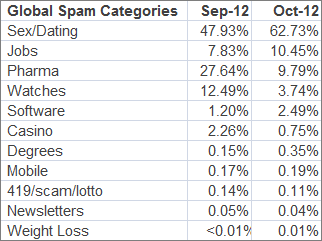
Although email spam rates have recently shown a sudden decline, these rates cannot be compared to the small figures like 8% or 9% typical to the years 2001-2002. You can actually read our blog post on Email Spam Trends across 2001-2012 and feel nostalgic about the olden times…
So email spam is still a big problem both for companies and individuals. That means you still need a good time-proven solution to have a clean and organized Inbox. A good way to go is with EmailTray – an extremely smart email client that sorts all incoming emails and groups them under the Top Priority, Low Priority, No Priority and Spam tabs. EmailTray comes as a Windows email client and an Android email app, both of which are available for free. Get yours now and enjoy a more spam-free mailing experience.
In a matter of just the past 10 years, email spam has become a multimillion industry. Despite a significant drop in email spam in 2011 (dropping to an average of 75.1% of all email in 2011 compared with 89.1% in the year of 2010), spam continues to be a serious problem for many companies and individual email users.
Email Spam Rate: Fluctuations Over Time
According to a Symantec Intelligence Report issued in February 2012, global spam levels continued to fall, as it now accounts for 68% of global email traffic. If we compare these figures to the data from the previous years’ reports, we’ll see that the email spam rate has been continuously decreasing within the last three years:
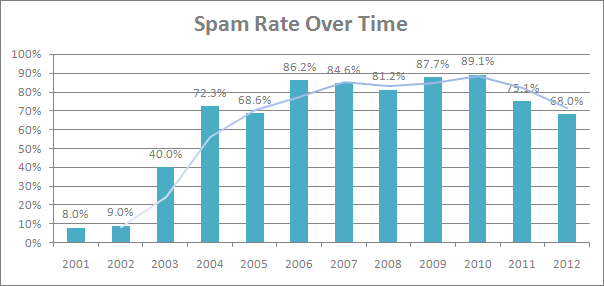
Back in 2001, about 8% of all mail was identified as spam. In 2002 this figure was 9% or 1 in 11.During 2003, MessageLabs Anti-Spam service identified 40% of emails scanned as spam.
The overall spam trend for the first half of 2005 saw a leveling of spam in line with the 2004 yearly figure of 72.3%, with an annual average percentage of 68.6% emails being identified as spam.
One of the key developments in 2006 was a significant increase in spam activity, with levels reaching 86.2%, the highest experienced since 2001.
2007 was the year when botnets came of age. The overall spam trend for 2007 was around 84.6%. Total spam levels averaged 81.2% for the year 2008.
But in 2009 the annual average spam rate was 87.7%, an increase of 6.5 percent on the 2008 statistic. In 2010, the average global spam rate for the year was 89.1%, an increase of 1.4% compared with 2009.
In 2011 the spam rate dropped to an average of 75.1% of all email. The dramatic decline, beginning December 25, 2010 and continuing through January 1, 2011, was the result of both a halt in the spam-sending activities of three botnets – Rustock, Lethic and Xarvester – as well as unrest among pharmaceutical spam-sending gangs.
In the current year of 2012, spam levels have continued to decrease, reaching 68% of all mail in February 2012. Of course things might change by the end of the year and show a totally different picture. However we’ve been observing a descending trend within the last three years so far.
Most Spammed Countries
In February 2012, the highest volume of spam was detected in the electronic mail of Chinese users: 74.7% of all mail. Residents of The Netherlands found a 70% rate of spam messages among their mail. In the US, 68.9% of email was spam; South Africa accounted for 68.8% of spam. UK email users faced 68.6% of spam. Canada and Australia reported slightly lower figures: 68.5% and 68.3% respectively. 67.9% of spam was reported by Hong Kong users as well as users from Germany; Japanese users experienced 65.1% of spam in their mail.
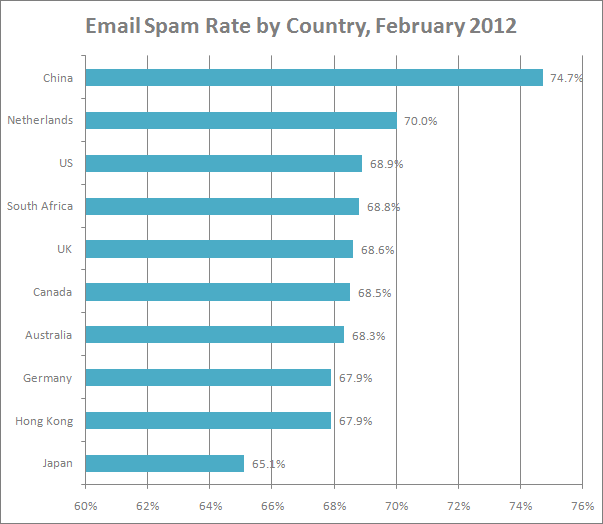
Top Spam Categories
According to a Symantec Intelligence Report issued in February 2012, the most common category of spam was related to the Adult/Dating category, overtaking pharmaceutical related spam for the first time:
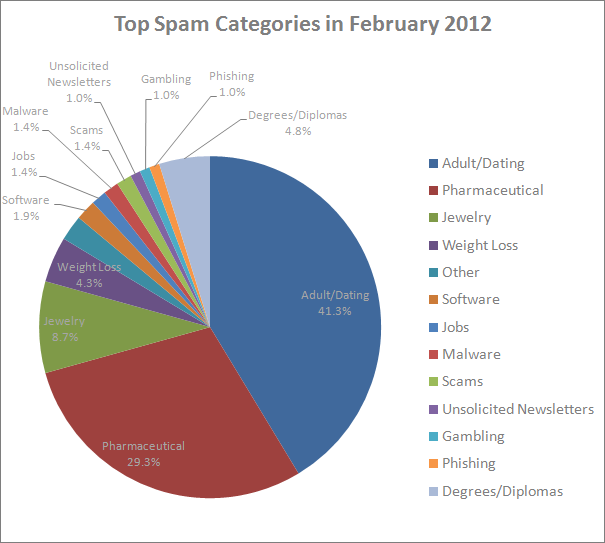
There were particular grounds accounting for the shift in email spam categories. Between 2010 and 2011, pharmaceutical spam fell by 34%, in large part owing to the demise of the Rustock botnet, which was mainly used to pump-out pharmaceutical spam. In contrast, messages about watches and jewelry, as well as sex and dating, both increased as a percentage.





